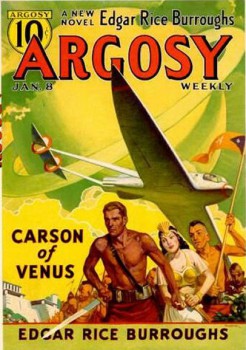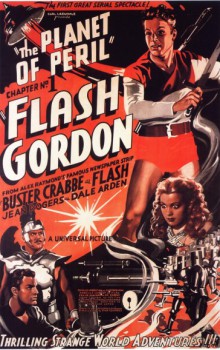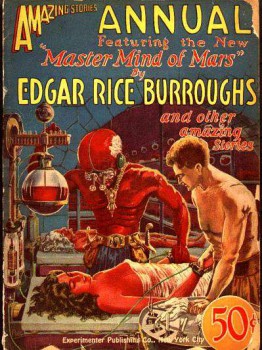What Would it Look Like to Pull a Watchmen on Planetary Romance? Part II
 When we last left our intrepid blogger (me) two weeks ago, he was blogging (very roughly) about the superhero genre, pre- and post-Watchmen, and the kind of light that Alan Moore’s Watchmen shone onto superhero comics. I did this because I think Moore did something very special and I wondered if it could be done to other fields, especially planetary romance.
When we last left our intrepid blogger (me) two weeks ago, he was blogging (very roughly) about the superhero genre, pre- and post-Watchmen, and the kind of light that Alan Moore’s Watchmen shone onto superhero comics. I did this because I think Moore did something very special and I wondered if it could be done to other fields, especially planetary romance.
I ended on a cliffhanger. And now, Part II….
I said last time that most of the traditions of the superhero genre were born in a very brief period between 1938 and 1945. In fact, the elements of the superhero tradition come part and parcel from the larger pulp tradition, which contained westerns; gritty and occasionally lurid detective stories; and planetary romances like Buck Rogers, Flash Gordon, John Carter of Mars, and Carson Napier of Venus.
The planetary romance tradition was powerfully tailored to its key market: white male American teens and men. If you were an under-appreciated teen with hero or power fantasies, pulp was your thing.
The heroes were young, white, smart, good looking, physically able, self-deprecating, and commanding. They confronted immediate perils (like a monster) or vast dangers (like an invasion), often single-handedly, or from a position of inspiring leadership.
And the opponents the hero fought were most often one-dimensional, morally-destitute cardboard placeholders for savage (non-whites) in our world, a view consistent with racial views of the late 19th century.
 And this hero was also something else that his reader was not: appreciated. By women. By society. By military and social leaders. No one ever doubted the hero’s plan or felt anything but relief when he took over to solve the problem, no matter what culture he happened to be in.
And this hero was also something else that his reader was not: appreciated. By women. By society. By military and social leaders. No one ever doubted the hero’s plan or felt anything but relief when he took over to solve the problem, no matter what culture he happened to be in.
He was (and is, for those planetary romances that are being written today) Nietzsche’s superman, the one who is superior to other men and who waits only his recognition. Heady stuff for male teens from a marketing point of view.
But I don’t want to present an unbalanced view. It was not all immature hero wish-fulfillment. Its heroes were and are heroic, selfless, courageous, loyal, open to love, and respectful when treated with respect. They lived in an optimistic world where, as the old saw in comics goes, the laws of morality were unbreakable and the laws of physics were flexible.
They carried forward youthful confidence in morals that were admirable in their intent, even if they were one-dimensional and culturally narrow. That confidence and the vigorous energy of the heroes and the racing plots captivated. And planetary romances transported the readers to fantastic worlds.
There’s a lot to love in planetary romance, as there is with comic books and their indigenous inhabitants, the superheroes. This is why I think that a Watchmen-like event would be healthy for planetary romance.
 Watchmen poked a lot of holes in superheroes, not all of which have been patched up since the 1980s, but it was a shot of modernism that dragged the superhero closer to today.
Watchmen poked a lot of holes in superheroes, not all of which have been patched up since the 1980s, but it was a shot of modernism that dragged the superhero closer to today.
So where are we?
We’ve talked about the conventions of the superhero and how Watchmen challenged those traditions. We’ve dug deeper into the pulp world, into the antecedents of superheroes, many of which existed before the phrase science fiction did.
We’ve now all the pieces in place to dive into the last part of this series: What a Watchmen-like treatment of planetary romance might look like.
So in the best pulp tradition, we’ll leave on this cliffhanger and see you in two weeks!
Derek Kunsken is a writer of science fiction, fantasy and sometimes horror, living in Gatineau, Quebec. You can find out more about him at www.derekkunsken.com or @derekkunsken.
Deconstructing classic pulp is hardly original. Most of it was crude mockery, and started in the late 70s and tapered off in the mid-90s.
There’s one de-construction I do like, Philip Jose Farmer’s “To a Feast Unknown” series that mainly focused on Tarzan and had him fight Doc Savage. To a lesser extent there was “Lord Tiger” which just focused on Tarzan being ‘created’ by a rich guy who’d read too many Burroughs stories, yet his fruit seemed to be closer to the other Burroughs. But he did a brilliant imagination on what a “Real” Tarzan would be, along with other “Real” pulp heroes.
More or less pulp is now ignored save mockery by the mainstream media because it has “Retro Appeal”. Oh, stuff does get through, like “Mom and Dad save the universe”, “Galaxy Quest”, “Zap Brannigan” from “Futurama”. But I think they fear that same retro appeal, and want to just keep putting out slurry.
Disclaimer, of course, I’m FOR classic Pulp for the same reasons you seem to be de-constructing it. Not just stories, imagine a “Retro Future” party to take some of the Tea Party’s hot air and put it to constructive use?
I love Sword and Planet stories and have since I stumbled over A Princess of Mars. ( I run http://www.barsoomia.org) A great deal of the appeal to me was the world building. If it’s just knock off with giant bugs I’m not as interested. Being so fond of the genre I grew my own a couple years of back. I created the art and worked with a group of writers to create collection of illustrated Sword and Planet stories called Strange Worlds Anthology. It was very much labour love. I’d love to see Sword and Planet be A Thing again, it’s not so much the type of story ( although swords have to be involved ) but the setting.
http://jeffdoten.dunked.com/strange-worlds-anthology-an-illustrated-collection-of-sword-planet-stories